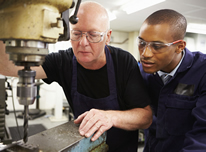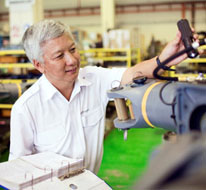Workplace Redesign for Older Workers
- Employees aged 55 and older accounted for 20.6 % of total covered employment in Iowa.1
- One-third of the US labor force will turn 55 by 2015, a demographic change labeled “The Gray Shift.”2
Older employees have years of experience in problem solving and have an abundance of knowledge to share with younger coworkers. This promotes worker loyalty and reduced training costs for the employer. But as workers age, physical and mental capabilities can change. Workplaces need to adjust and adapt to the following issues3:
Physical
Strength and Flexibility: People lost 20-30% of their strength between ages 20 and  65, and flexibility decreases 18-20%. Lifting and carrying are more difficult, and older workers are more prone to musculoskeletal injuries such as sprains, tendonitis, carpal tunnel, and lower back pain 65, and flexibility decreases 18-20%. Lifting and carrying are more difficult, and older workers are more prone to musculoskeletal injuries such as sprains, tendonitis, carpal tunnel, and lower back pain
Balance: One-third of people 65 or older fall each year
Manual Dexterity: motor skills decrease
Physiological
Older worker’s bodies experience change. Major concerns include:
Fatigue: occurs more rapidly
 Oxygen exchange: 40% decrease at 65 years
Oxygen exchange: 40% decrease at 65 years
Systemic blood pressure: increases
Extreme temperatures: more challenging for the worker
Psychosocial
Aging workers may have different shift preferences, prefer structured training, and are more likely to experience disengagement with their work. Employers should be aware of the above issues of older adults and know how to accommodate them. Many companies turn to ergonomics. Lance Perry, Senior Engineer/Ergonomist at Zurich, notes that “ergonomic programs have two fundamental control measures”4:
Administrative solutions: these focus on the worker via improvement programs, policies and procedures. Actions taken by management or staff may include training, job rotation, stretching and conditioning programs, and return-to-work strategies.
Engineering solutions: these focus on the job and work environment. The job, tools, equipment and environment are redesigned to achieve control over risk factors such as poor performance and injuries and illness. These controls include:
- Task design (repetition, rate, static vs dynamic muscle activity)
- Workstation design (work surface height, reach zones, chairs, floor mats)
- Environmental design ( lighting, temperature, footwear and gloves)
- Tool design (grips, weight, balance, vibration)
- Equipment design (knobs and switches, keyboard and mouse, lettering and character size, colors)
Ten thousand US workers turn 65 every day5—aging workers are valuable workers that represent a large proportion of the workplace’s knowledge and skill. The ergonomic redesign of the workplace enables aging employees to adapt and remain vital and productive, which benefits all.
1 Older Workers in Iowa: June 2012. Iowa Workforce Development and U.S. Census Bureau Partnership.
2 Gray Shift Part 1: An Aging Workforce Creates New Workplace Injury Issues. Earl Hagman, Ergotech Inc.
3 Designing the Workplace for the Aging Workforce. Lance S. Perry, Zurich Services Corporation.
4 Designing the Workplace for the Aging Workforce. Lance S. Perry, Zurich Services Corporation.
5 Ergonomics and the Aging Workforce- Designing a Safe and Productive Workplace. Mark Middlesmith, Ergonomics Plus.
|